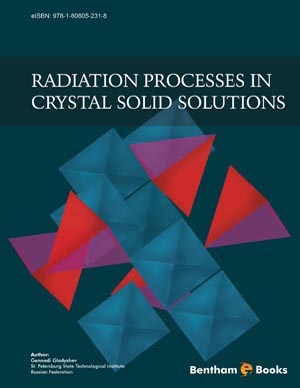Kinds and Properties of Radiation: Lattice Defects in Metals and Alkali Halides
Page: 3-11 (9)
Author: Gennadi Gladyshev
DOI: 10.2174/978160805231811201010003
PDF Price: $15
Abstract
The main kinds, properties and radiation units of measure are considered. The data on the path of the microparticles in metals and air are presented. The crystal structure of the metals and alkali halides is considered. The models of various kinds of structural defects (point, linear, volume) in crystal lattice are discussed.
Intrinsic Radiation Defects and Their Production Mechanisms
Page: 12-25 (14)
Author: Gennadi Gladyshev
DOI: 10.2174/978160805231811201010012
PDF Price: $15
Abstract
Models and mechanisms of intrinsic radiation defect formation in the metals and alkali-halide crystals are considered. The effect of irradiation conditions (temperature, absorbed dose, etc.) on the formation of the primary and secondary defects, fomation of the aggregate radiation defects (voids), and affection of heat treatment on the properties of irradiated metals are discussed herein. It is noted that low radiation resistance of alkali halide crystals is connected to the under-threshold mechanism of defect formation.
Impurity Radiation Defects
Page: 26-33 (8)
Author: Gennadi Gladyshev
DOI: 10.2174/978160805231811201010026
PDF Price: $15
Abstract
The models and thermal stability of the impurity radiation defects in the metals and alkali halides are reviewed. Due to the ionic lattice structure and presence of two sublattices in alkali halides, the formation of much larger number of types of impurity radiation defects than in metals is possible. The most important in the radiation processes are the complexes of self-interstitial-impurity and vacancy-impurity.
Effect of Impurities on the Radiation Defect Formation
Page: 34-39 (6)
Author: Gennadi Gladyshev
DOI: 10.2174/978160805231811201010034
PDF Price: $15
Abstract
The effect of impurity atoms on the efficiency of formation and accumulation of radiation defects in the metals and alkali halide crystals is considered. Interaction of impurities with radiation defects can both promote stabilization of the structural disorder, and suppress the radiation-defect formation. Especially the complex processes take place in the irradiated alkali halide crystals, where a wide variety of the radiation-induced defects is possible.
Diffusion Under Irradiation
Page: 40-49 (10)
Author: Gennadi Gladyshev
DOI: 10.2174/978160805231811201010040
PDF Price: $15
Abstract
Some experimental data on the radiation-stimulated diffusion in metals and alkali halides are presented. The diffusion mechanisms in the crystal solids under irradiation and the effect of temperature irradiation on the diffusion are discussed. It is noted that the super-equilibrium point defects play a major role in the radiation-stimulated diffusion.
Decomposition of the Solid Solutions Under Irradiation
Page: 50-57 (8)
Author: Gennadi Gladyshev
DOI: 10.2174/978160805231811201010050
PDF Price: $15
Abstract
The experimental data of the effect of irradiation on the decomposition of alloys and doped alkali halide crystals are presented. Depending on the composition of the solid solution and other conditions, the irradiation can both accelerate and induce the decomposition. The mechanisms and some features of the decomposition of solid solution under irradiation are discussed.
Theoretical Estimates and Models of the Radiation Stability of Crystal Solid Solutions
Page: 58-70 (13)
Author: Gennadi Gladyshev
DOI: 10.2174/978160805231811201010058
PDF Price: $15
Abstract
The factors affecting the stability of solid solutions under irradiation are considered. One of these factors is the radiation-induced change of solubility. The models describing the radiation-induced decomposition of the solid solution for the different concentrations of impurities and irradiation conditions are discussed.
Radiation-Stimulated Segregation
Page: 71-85 (15)
Author: Gennadi Gladyshev
DOI: 10.2174/978160805231811201010071
PDF Price: $15
Abstract
The experimental data and models of radiation-induced segregation are presented. The mechanism and efficiency of the radiation-induced segregation depend on several factors: the irradiation temperature, the concentration and size of atoms of impurity, the presence of additional impurity, etc. The majority of models which describe the radiation-induced segregation, include a system of kinetic equations for the various kinds of point defects and alloy atoms. The models differ from each other in a set of the types of defects and calculation parameters.
Radiation-Induced Disordering and Amorphization
Page: 86-91 (6)
Author: Gennadi Gladyshev
DOI: 10.2174/978160805231811201010086
PDF Price: $15
Abstract
The radiation-induced disordering and amorphization are considered. These phenomena are not connected with the fluxes of impurity atoms and radiation defects. The criteria for radiation amorphization which is connected with the degree of mixing of the alloy components, are discussed.
References
Page: 92-101 (10)
Author: Gennadi Gladyshev
DOI: 10.2174/978160805231811201010092
PDF Price: $15
Introduction
Radiation Processes In Crystal Solid Solutions is a monograph explaining processes occurring in two classes of crystal solids (metal alloys and doped alkali halides) under irradiation by various types of radiation (alpha, beta, gamma, X-radiations, ions). While metal alloys may differ in high radiation stability, solid solutions based on alkali halides are very radiation-sensitive materials. Radiation defect production mechanisms, intrinsic and extrinsic radiation defects, a role of complexes an impurity-radiation defect which explain distinction in radiating stability of the specified classes of solid solutions are discussed in this e-book. To describe radiation induced phase transformations, two approaches are highlighted: kinetic and thermodynamic. This e-book also includes research on the effect of small radiation doses in a structurally solid phase state of a solution along with a semi-quantitative estimation of radiation effects with respect to temperature changes. This e-book should be a useful reference for advanced readers interested in the physics of radiation and solid state physics.













